There’s something magical about a watermaker—at least that’s how I felt after we installed one on our boat. That may sound overblown, but think about it: watermakers transform salt water into fresh water, providing a near-endless supply of potable water for drinking, bathing, and cleaning! THAT my friends is an amazing piece of technology!
(If you don’t share my enthusiasm, try going without a shower for a few days and you’ll begin to see my point).

Having experienced living on a boat and cruising, both with and without a marine desalinator, I can attest that it’s a game-changing piece of gear. However, you definitely don’t need one to go cruising. There are plenty of low-tech ways to collect and make water on a boat.
Marine desalinators do offer some major benefits: there’s more water for showers, it’s easier to travel farther afield, you can spend more time in a remote location. However, these benefits have to be weighed against the drawbacks: namely a hefty price tag and ongoing maintenance.
Deciding whether a watermaker is right for you will come down to the type of cruising you’re doing, how much water you need, and your budget. Read on to learn about the pros and cons, costs, and key features of marine watermakers.
Table of contents
How does a watermaker work?
A watermaker on a yacht converts seawater into fresh water through a process known as reverse osmosis (RO). A high-pressure pump pushes seawater through a semi-permeable membrane that filters out salt, organics, and bacteria. The fresh water is pumped into your water tanks while the remaining brine bi-product is discharged over the side of the boat, back into the ocean.
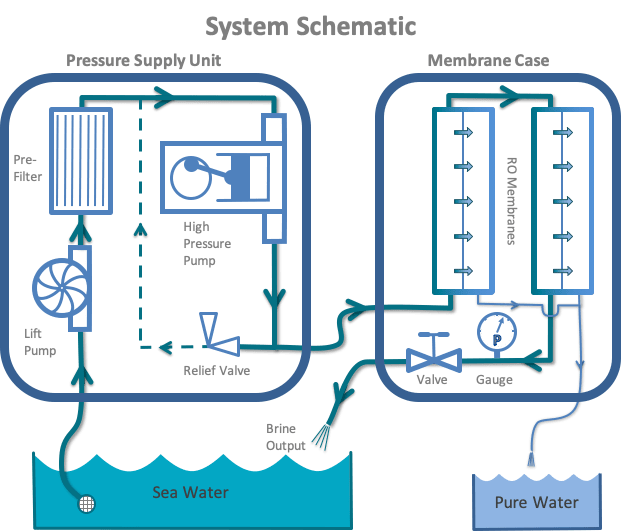
Marine watermakers: the benefits and drawbacks
Benefits
Less water rationing
When we started our 13,000 mile trip across the Pacific, we didn’t have a watermaker. We were on a tight budget and decided to prioritize other pieces of equipment like a life raft and wind vane.
As a result, we became experts in conserving water on a boat. We would carefully ration out water for washing dishes, taking showers, and even brushing our teeth!
After getting a watermaker we became far less meiserly because we knew we could always make more water if we needed to. It was a relief to not be constantly thinking about how much water we were using over the course of a day.
That being said, we couldn’t relax completely. We had to keep our tanks topped up, so as not to run the pump dry. We also always carried potable water in reserve, in case our watermaker broke in the middle of a long passage.
More luxuries
Can’t live without a proper shower? A boat water maker can make water-intensive luxuries like freshwater deck washdown, freshwater flushing heads, laundry, daily showers, and even baths, a possibility.
As great as this sounds in theory, we were surprised to find that we didn’t indulge in more showers after we got the watermaker.
We continued to use a hand pump pesticide sprayer to shower on deck despite having a watermaker and shower below. While some of this came down to habit, we also disliked running our engine (and consuming diesel) just to run the watermaker.
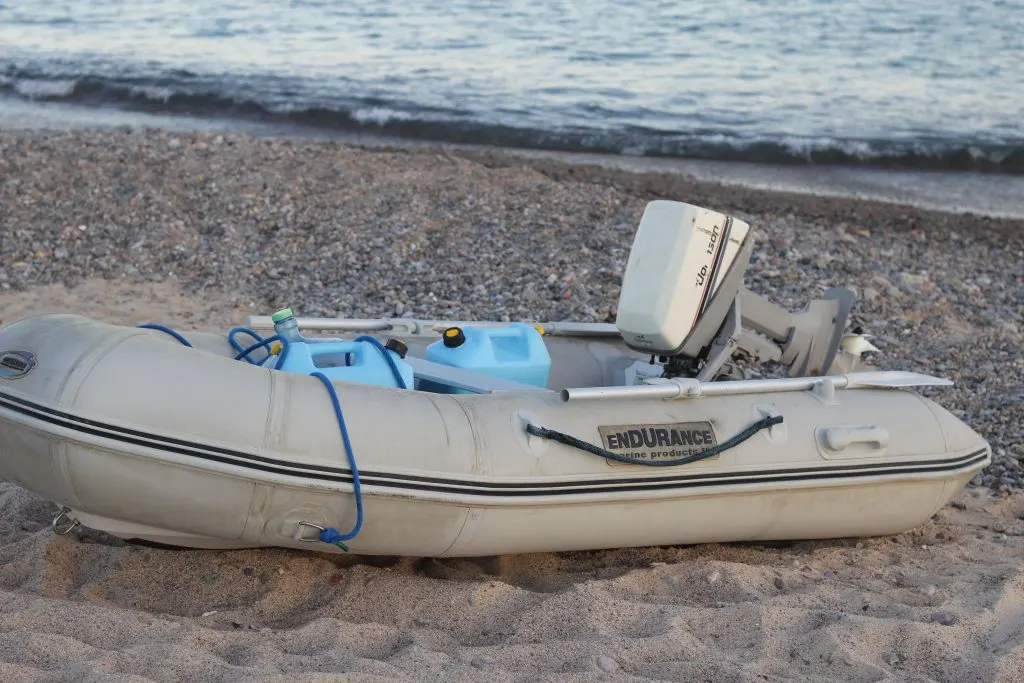
No hauling water
For us, this was by far the greatest benefit of having a watermaker!
While cruising in the US and Canada, we could refill our water tanks at a dock or marina. This was a minor hassle because it involved pulling up the anchor and docking the boat.
In Mexico, it was more challenging to get water. We would fill 5-gallon jugs at the local water purification plant in town and wheel them back to our boat on a collapsible dolly.
It often took a couple of trips with the dolly and dinghy to fill our water tanks. Oh, and we broke our dolly, twice!
We realized that if we wanted to spend more time exploring, and less time hauling water, we would have to invest in a watermaker. When we reached La Paz, Mexico we bought a refurbished watermaker, and we were so glad we did!
Our sailboat water maker gave us the gift of time, especially in places like Mexico and the South Pacific, where there were limited opportunities to fill water tanks up at the docks. It also saved us paying docking and water fees.
We estimate that our boat water maker saved us anywhere from four to six hours every week, time that we could spend exploring the wonderful places we were visiting.
A clean, safe water source
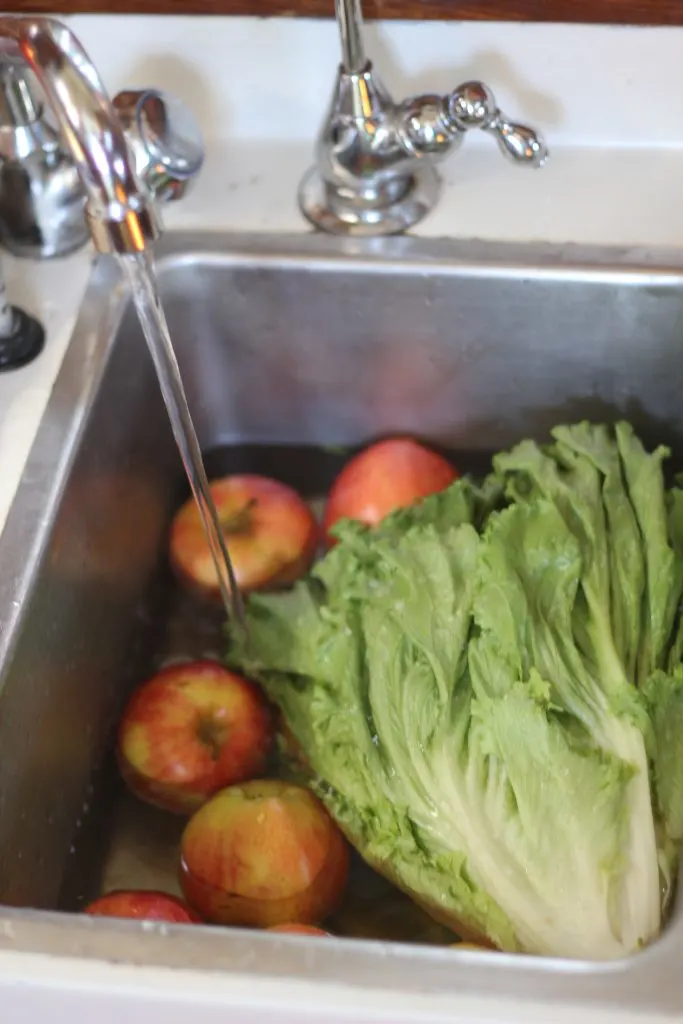
In places where the drinking water may be suspect, a boat water maker can be a reliable source of safe drinking water (assuming it’s in good working condition!).
More time in remote locations
A watermaker is a great tool if you’re drawn to remote locations where you might be the only boat in the anchorage.
It wasn’t until we reached Los Frailes, a secluded village on the Baja, that we really began to think about buying a watermaker.
There we were in an idyllic anchorage, surrounded by spectacular hiking and fishing. There was only one problem—every two days we had to walk 10 miles into town with our water jugs and hope that some kind samaritan would give us a lift back to our boat.
Before having a watermaker, we’d often leave a place we loved just because we needed to fill up our tanks. With a watermaker, we were more self-sufficient and could stay an extra few days, or as long as we wanted!

Drawbacks
Cost
The number one drawback is the cost. We were able to find a refurbished water desalinator for $3,000, which was a great deal but also a considerable slice out of our cruising kitty.
How much does a watermaker cost?
Powered desalination systems for your average recreational cruising boat range from around 3,500 USD to 11,000 USD, with the more expensive options offering higher production (gallons of fresh water per hour).
Ongoing maintenance
Watermakers are yet another piece of boat equipment that needs to be maintained.
The majority of watermaker problems are caused by not using it enough or not using it properly.
If a watermaker is not used for a few weeks, the planktonic organisms in the seawater will die, rot, and clog the membrane and filters. This can eventually damage the reverse osmosis membrane in the watermaker.
For this reason, boat water makers should be used frequently and regularly flushed with fresh water.
Watermaker flushing
Check your manufacturer’s instructions on how to flush.
Rainman recommends flushing the seawater out of the system with fresh water if you are not using the system for more than a day or two. After another week, you need to freshwater flush the system again or pickle it for long-term storage.
Of course, it’s easy to forget, so we made it a rule to freshwater flush our watermaker after every use.
This is one good reason to choose a watermaker with an output that will meet your water consumption needs but not exceed them. If you’re using it every second day, you won’t have to try and remember whether you’ve flushed it or not.
Flushing a watermaker is relatively simple but it does involve a bit of work. We used a system with buckets of fresh water to flush our system and it generally took about 5 minutes.
You can also buy systems that automatically flush your watermaker at pre-determined times—even when you’re away from the boat (more on autoflush systems below).
Whatever you do, don’t use chlorinated water to flush as it will destroy reverse osmosis membranes. It’s possible to buy a carbon filter to remove chlorine from water sources at the dock.
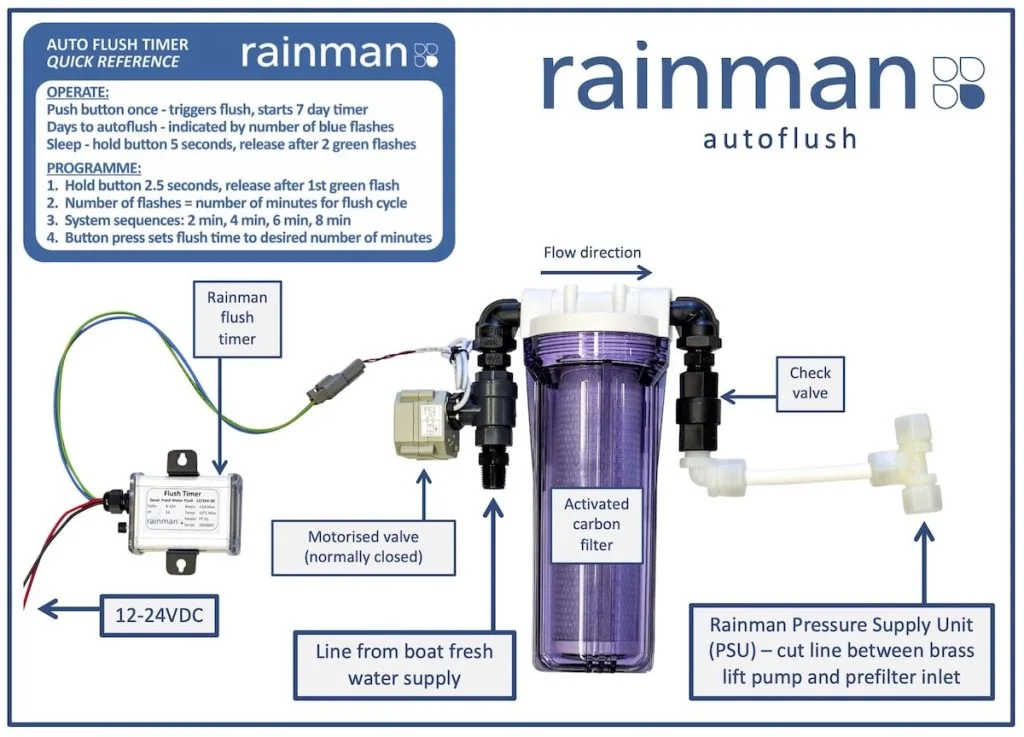
Pickling a watermaker
If you don’t plan on using your watermaker for a while it needs to be “pickled” with a special biocide to prevent growth and buildup which could render your reverse osmosis membrane totally useless.
A watermaker should also be pickled every so often to chemically cleanse the membrane.
In addition to flushing and pickling, you will also need to clean out and replace the raw water pre-filters.
Operating costs
When properly cared for, a membrane should last five to ten years. If you don’t properly flush or pickle your watermaker, it can be a lot sooner and membranes aren’t cheap, generally costing in the range of 200-700 USD.
You’ll also need to purchase pre-filters and pickling solution, which are generally quite affordable. It’s also a good idea to carry spare parts
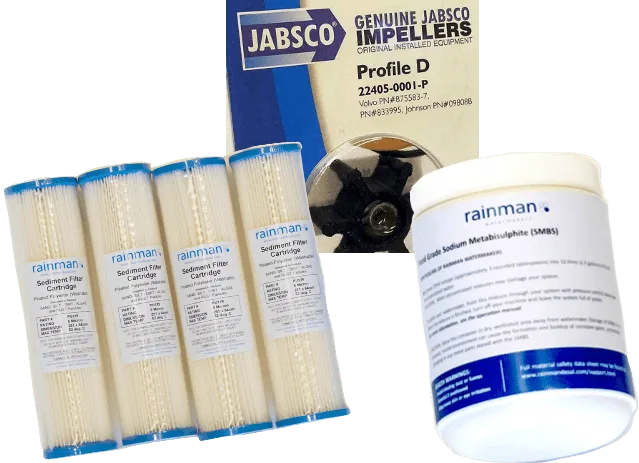
Power consumption
Watermakers can be real power hogs. When Practical Sailor tested a dozen DC watermakers they found they could draw anywhere from 12 to 48 watts per gallon, a huge range in efficiency!
According to Practical Sailor, “for maximum efficiency none of the systems drawing 15 amps or more should be operated without running the engine at the same time.”
We had to run our engine for hours to fill our tanks, which was annoying (and loud) when we were hanging out at anchor and also used up another finite resource—diesel fuel.
In our view, this was the single largest drawback to having a watermaker aboard.
Keep in mind that your power supply will determine what type of watermaker you buy. You may need to upgrade your electrical panels, get a generator or high-powered alternator, add solar panels, or increase battery capacity to supply the demand.
You can’t make water everywhere
While watermakers offer great flexibility and freedom, you can’t just make water in any old spot. If you make water in a polluted marina or anchorage, you’ll risk clogging up your filter. Most cruisers will head out to open water to ensure the saltwater they’re using is as clean as possible.
Key features to look for
Powered or handpump
Handpump watermakers
Handpump watermakers tend to be small and portable, the perfect thing to keep in your ditch bag in the event of an emergency. They’re less expensive than powered watermakers and produce far less water, usually around one gallon per hour.
Though I do know cruisers who have used a handpump watermaker for everyday use, they typically tend to be kept aboard for survival situations.
Powered watermakers
Powered watermakers run off your electrical supply or engine and can produce tens of gallons of water per hour. They tend to be a lot more expensive, but they’re productive enough to replenish your tanks.
Electric or engine drive
Powered watermakers can be electrically driven, by AC or DC, or run off the boat engine.
AC watermakers
AC models can produce in the range of 20-60 gph and are ideal for cruisers with an AC generator or alternator on board. They can also be used on boats with ample solar or wind sources and an inverter.
DC watermakers
DC watermaker systems typically produce in the range of 10-30 gph and are ideal for boats with solar power or 12V battery power.
Engine-driven watermakers
On an engine-driven watermaker, the high-pressure pump is belt-driven. These can produce a considerable amount of water, even on small engines. For instance, engine-driven units produce between 20-60gph, twice what a DC unit can produce.
Energy recovery watermaker
DC watermakers have become more efficient in recent years thanks to energy recovery systems (ERS). When the water leaves the watermaker it is still under pressure. ERS uses a set of valves to make use of this excess pressure to help drive the pump, which can reduce energy consumption by as much as 80 percent.
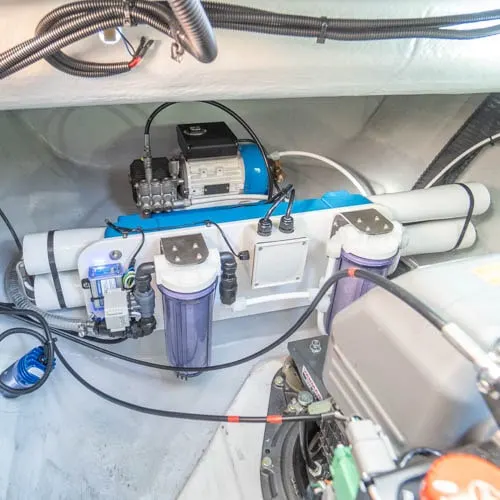
Modular, self-contained, and portable watermakers
Watermakers can be bought as modular, self-contained, and portable units. Choosing the right one may depend on your boat size and layout and whether you’re comfortable installing the watermaker yourself.
Modular units
Modular units come as several separate components that you can mount and connect yourself. This obviously offers a lot more flexibility and is particularly useful on smaller vessels where you may not have a lot of space. The downside is that these systems will take longer to install.
Self-contained units
Self-contained units arrive pre-assembled. While easier to install, they’re often bulkier and best suited to a bigger cruising sailboat with a large engine room.
Portable watermakers
Portable watermaker systems, like the Rainman watermakers, are entirely self-contained. Their compact design makes them easy to move and stow and you can completely avoid a permanent installation.
Simply put the intake and brine discharge hoses overboard, the freshwater hose in your water tank and you’ll be making water in no time.
If you race, have multiple boats, or plan on selling your boat, a portable watermaker is a great option because it can be easily moved from boat to boat.
If we were to buy another watermaker, we would probably opt for a portable one.
Automatic flushing systems
Automatic flushing systems use your boat’s freshwater supply to flush the watermaker for several minutes every few days. These systems require additional components (e.g., a timer, carbon filters, and a motorized valve) and installation but they take a lot of the maintenance out of having a watermaker onboard.
Automatic Pressure Regulation and adjustable pump speed
Your watermaker’s efficiency will be affected by the temperature and salinity of the water you’re cruising in. Cold and highly saline waters (e.g., in the high latitudes) will be more work for your watermaker, so it will take longer to purify.
Some units feature Automatic Pressure Regulation (APR) and adjustable pump speed which can help compensate for fluctuations in water temperature and salinity.
Remote control panels
Some watermakers have the option of a control panel which allows for easier access and remote control. Control panels tend to have a fairly simple interface with just a few gauges but may include a salinity sensor—so you can keep tabs on water quality—and auto-flush integration—so you can flush your watermaker with the flip of a switch.
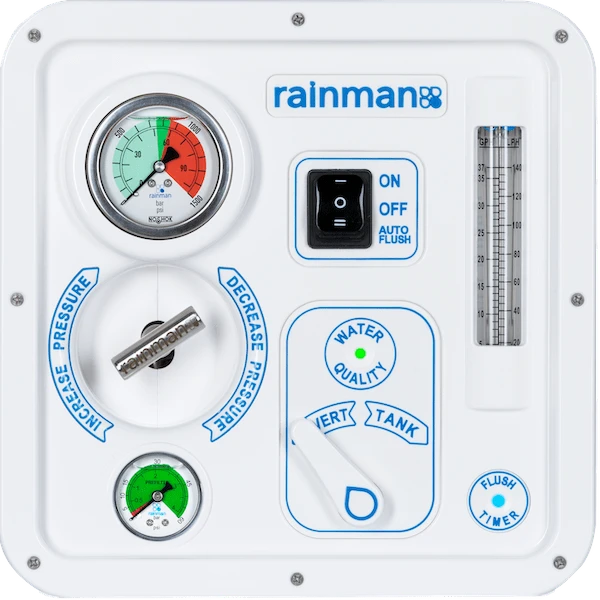
Top watermaker brands
If you’re considering buying a watermaker for a boat, here are some of the top brands to consider.
- Cruise RO Watermaker
- Dometic
- Echotec watermakers
- Horizon Reverse Osmosis (HRO)
- Katadyn
- Rainman
- Sea Recovery watermakers
- Schenker watermakers
- Spectra watermakers
Fiona McGlynn is an award-winning boating writer who created Waterborne as a place to learn about living aboard and traveling the world by sailboat. She has written for boating magazines including BoatUS, SAIL, Cruising World, and Good Old Boat. She’s also a contributing editor at Good Old Boat and BoatUS Magazine. In 2017, Fiona and her husband completed a 3-year, 13,000-mile voyage from Vancouver to Mexico to Australia on their 35-foot sailboat.
